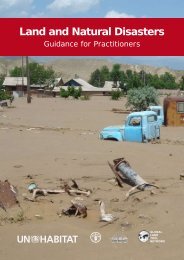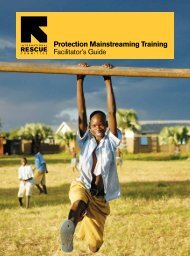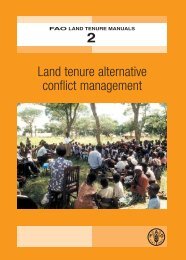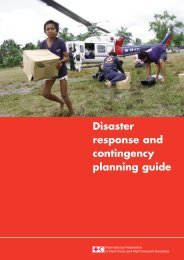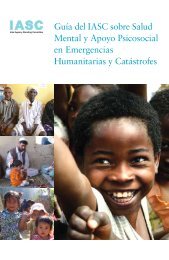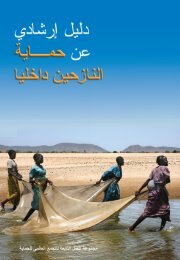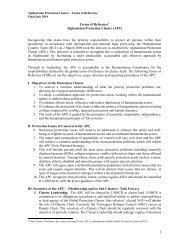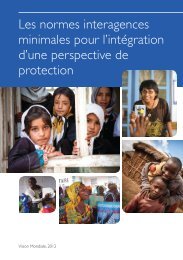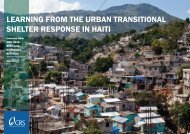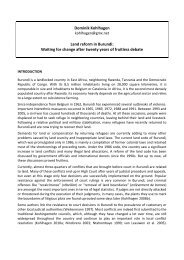Ano<strong>the</strong>r “atypical” partner that played a significant role during <strong>the</strong> humanitarian response was <strong>the</strong>Myanmar business community. From interviews with private sec<strong>to</strong>r representatives, local agencies,communities and observations by <strong>the</strong> IA RTE team it was evident that <strong>the</strong> business community inMyanmar had spent significant amounts <strong>of</strong> <strong>the</strong>ir own resources in providing humanitarian assistance.Some companies started relief activities almost immediately, even before <strong>the</strong> government requested<strong>the</strong>ir support. Activities ranged from distributing relief items, <strong>to</strong> mobilizing <strong>the</strong>ir employees in<strong>to</strong>relief teams, <strong>to</strong> constructing shelters, <strong>to</strong> provision <strong>of</strong> logistic support <strong>to</strong> humanitarian operations(including providing warehouse space and transport for aid donated by international organizations atno cost). Some companies have also committed <strong>to</strong> constructing cyclone shelters. As with localagencies, <strong>the</strong> role <strong>of</strong> <strong>the</strong> private sec<strong>to</strong>r in <strong>the</strong> response <strong>to</strong> <strong>Cyclone</strong> <strong>Nargis</strong> remains largelyundocumented and invisible outside <strong>of</strong> Myanmar.<strong>Inter</strong>viewees and reports indicate that activities <strong>of</strong> local businesses were coordinated <strong>to</strong> some extentby <strong>the</strong> government, but remained mostly uncoordinated with/by <strong>the</strong> international community withsome exceptions <strong>of</strong> NGOs and donors utilizing private companies for specific tasks (e.g. cus<strong>to</strong>msclearance, transport and logistics). In future emergencies it may be possible <strong>to</strong> utilize <strong>the</strong>separtnerships more effectively.3.12 Coordination StructuresCoordination involving international ac<strong>to</strong>rs occurred at various levels, and included both standardand “atypical” coordination mechanisms, <strong>of</strong> which one example is <strong>the</strong> Tripartite Core Group (TCG),an ad hoc coordinating body that brings <strong>to</strong>ge<strong>the</strong>r senior levels <strong>of</strong> Myanmar government, <strong>the</strong> UN, andASEAN <strong>to</strong> facilitate humanitarian operations in <strong>the</strong> Delta. Based on interviews <strong>of</strong> both national andinternational agencies along with a review <strong>of</strong> minutes, guidelines and <strong>to</strong>ols, coordination has beenrelatively good at <strong>the</strong> central level. There was unanimous praise from international agenciesregarding TCG achievements in opening humanitarian space, and similarly that HumanitarianCoordina<strong>to</strong>r had fulfilled his mandate extremely effectively under challenging circumstances.The NGO Liaison Officer position in Yangon combined with <strong>the</strong> Local Resource Center (LRC) wereobserved <strong>to</strong> perform a number <strong>of</strong> particularly useful functions including acting as a liaison betweeninternational and national agencies, facilitating access <strong>to</strong> information and providing outreach <strong>to</strong>national NGOs, capacity-building for local NGOs, and providing an alternative meeting space foragencies. The IA RTE itself can be seen as a successful “test” <strong>of</strong> this model since in <strong>the</strong> absence <strong>of</strong><strong>the</strong>se resources it would have very difficult <strong>to</strong> have such a substantive NGO involvement in <strong>the</strong>process. The team’s assessment is that this model provided <strong>the</strong> basis for similar outreach initiativesat hub level.The body best positioned <strong>to</strong> lead <strong>the</strong> international component <strong>of</strong> planning and prioritization is <strong>the</strong>local IASC. However, as currently constituted it more resembles a standard humanitarian briefing.While this continues <strong>to</strong> be required it should be chaired by OCHA and include nationalorganizations. With <strong>the</strong> departure <strong>of</strong> <strong>the</strong> Humanitarian Coordina<strong>to</strong>r it is an opportune time <strong>to</strong> reviewthis mechanism and establish a truly strategic, policy setting IASC. This would require <strong>the</strong>international NGOs, through <strong>the</strong>ir existing forum, <strong>to</strong> elect representatives <strong>to</strong> <strong>the</strong> IASC.A hub-level LRC, with national NGO Liaison Officers, could serve <strong>to</strong> ensure national ac<strong>to</strong>rs arebetter integrated in<strong>to</strong> planning and coordination exercises, assist with data collection <strong>to</strong> improvenational inputs <strong>to</strong> ongoing information management, provide capacity building services, and bring <strong>to</strong>attention issues raised by national ac<strong>to</strong>rs working outside <strong>the</strong> traditional coordination structures.26
Findings on cluster coordination are detailed in Section 16.8.3.12.1 Coordination RecommendationsR.10. As is increasingly common practice in o<strong>the</strong>r countries, <strong>the</strong> Humanitarian Coordina<strong>to</strong>r shouldoversee <strong>the</strong> formation <strong>of</strong> a strategic, policy setting local IASC which includes <strong>the</strong> UNmembers <strong>of</strong> <strong>the</strong> global IASC, <strong>the</strong> IFRC and ICRC (as an observers) and a small number <strong>of</strong>elected NGO representatives;R.11. To better support recovery at community level, <strong>the</strong> IASC should examine <strong>the</strong> feasibility <strong>of</strong>assigning a lead agency for those village tracts which have been most severely impacted, <strong>to</strong>improve coverage and aid effectiveness. Lead agencies could be UN agencies, INGOs ornational organizations and possess sufficient capacity <strong>to</strong> fulfill a lead role and plan <strong>to</strong> remainfor two <strong>to</strong> three years;R.12. OCHA should guide <strong>the</strong> adjustment and adaptation <strong>of</strong> coordination systems that are bettersuited <strong>to</strong> local ac<strong>to</strong>rs. This would include raising awareness amongst international agenciesabout alternative coordination mechanisms commonly employed within Myanmar. OCHAshould also support <strong>the</strong> development <strong>of</strong> outreach systems that are designed not only <strong>to</strong>improve communication and coordination with local agencies and communities, but also help<strong>to</strong> improve <strong>the</strong> reliability and consistency <strong>of</strong> data collection; andR13. Local Resource Centers, based on <strong>the</strong> model in Yangon, should be established at <strong>the</strong> hublevel, staffed with national NGO Liaison Officers, <strong>to</strong> provide outreach, improve access <strong>to</strong>information, streng<strong>the</strong>n hub-level coordination through working with <strong>the</strong>ir UN and ASEANcounterparts. National NGO Liaison Officers should be able <strong>to</strong> easily combine <strong>the</strong>ir outreachactivities with information collection <strong>to</strong> help improve <strong>the</strong> reliability <strong>of</strong> assessment andWWW data.3.13 Disaster Risk ReductionWhile <strong>Cyclone</strong> <strong>Nargis</strong> was <strong>the</strong> worst disaster <strong>to</strong> have struck Myanmar in living memory, <strong>the</strong>Ayeyarwady division in <strong>the</strong> Delta is not actually <strong>the</strong> area at greatest risk. As can be observed fromrisk maps attached as an annex <strong>to</strong> this report, <strong>the</strong> area <strong>of</strong> Myanmar most vulnerable <strong>to</strong> cyclones isRakhine State. There is also a significant seismic risk in different parts <strong>of</strong> <strong>the</strong> country and Myanmarhas high levels <strong>of</strong> disaster vulnerability.Experience elsewhere in <strong>the</strong> region has repeatedly demonstrated that preparedness and disaster riskreduction can significantly reduce vulnerabilities. As noted in a recent ISDR press release “Manycyclone-prone countries, such as … Bangladesh, have implemented efficient early warning systemsthat have reduced <strong>the</strong> death <strong>to</strong>ll caused by cyclones. When <strong>the</strong>re are comprehensive early warningsystems in place, starting from meteorological technology all <strong>the</strong> way through <strong>to</strong> preparedness andcontingency plans, people can be effectively warned and have time <strong>to</strong> evacuate <strong>to</strong> safer places.Bangladesh has a 48-hour early warning system in place that allows people <strong>to</strong> evacuate <strong>to</strong> safecyclone shelters hours before any cyclone makes landfall. This has drastically reduced <strong>the</strong>ir death<strong>to</strong>lls from cyclones - from 300,000 deaths from <strong>Cyclone</strong> Bhola in 1970, <strong>to</strong> 3,000 last Novemberduring <strong>Cyclone</strong> Sidr.” 1313 UN/ISDR 2008/05 Press Release 6 May 200827



